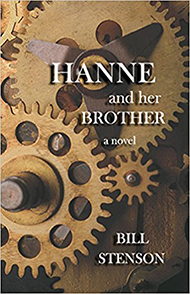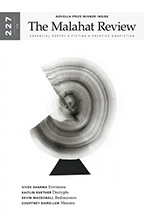Reviews
Fiction Review by Norma Lundberg
Bill Stenson, Hanne and her Brother (Saskatoon: Thistledown, 2016). Paperbound, 206 pp., $19.95
 My encounter with Bill Stenson's character Hanne Lemmon in his new novel has been unforgettable. Initially struck by her solitary circumstances, I became increasingly curious about her resilient inner strength, and grew to admire her and fear for her as her tale unfolded. Her isolation growing up in strict obedience to a taciturn father who seemed more attentive to the clocks he repaired than to her need for companionship seemed as forlorn as the early situation of Jane Eyre, a book she admired for the lesson of independence she felt she needed to learn.
My encounter with Bill Stenson's character Hanne Lemmon in his new novel has been unforgettable. Initially struck by her solitary circumstances, I became increasingly curious about her resilient inner strength, and grew to admire her and fear for her as her tale unfolded. Her isolation growing up in strict obedience to a taciturn father who seemed more attentive to the clocks he repaired than to her need for companionship seemed as forlorn as the early situation of Jane Eyre, a book she admired for the lesson of independence she felt she needed to learn.
Hanne begins the story of her early life by describing it as a “confession” and alerts the reader to a secret in her past. When she was a child, her parents had left Belgium for Canada in the late 1950s. Her mother died on the voyage, and her father brought her to a small town called Tensor near the coast of British Columbia to resume his profession repairing broken timepieces. A stern, silent man with a penchant for seclusion, he kept Hanne apart from the life of the town. She entered her teens in the 1960s as someone “measuring her life by the clocks ticking in the constant solitude ruling the house she dreams of leaving.” Her initial description of the natural beauty of the countryside contrasts with her growing sense of a community where life seems stagnant. The future prospects of its young people seem at a dead end, with little incentive to leave. She feels far removed both from them and from the world she had grown curious about from reading books from the town library. Home-schooled and friendless, she gradually learns her father's skills repairing clocks and imagines having a brother to share adventures with, hoping for something dramatic to break the monotony of her existence. When a dramatic incident occurs, it shocks her into a violent response unlike any she might have imagined.
Her father’s sudden death when she is sixteen leaves her alone and feeling even more disconnected. Her growing beauty attracts the attention of a troubled and violent boy she barely knows: his attentions resisted, he overpowers and rapes her. She retaliates in panicked self-defense only to realize she has killed him and needs to conceal the act, and his body. The shock of her brutally terminated childhood drives her self-determination to keep the incident unrevealed. Hanne is now committed to a radical shift in her life, complicated by her fear of eventual discovery, and by an unwanted pregnancy resulting from the rape.
The rest of the novel concerns the path of her life stage by stage to avoid the discovery of her actions as she becomes a mother, assumes her father’s profession, and tries to create a life of her own. Her point of view is the dominant one in the novel with the exception of a visiting boy who also doesn’t fit in to the community’s closed structure and has not been part of her life, but witnessed the rape. His knowledge about the incident threads through the novel as a potential threat to her resolve to bury the crime and remain in the town. As a plot device it serves to underline the ongoing tension she experiences relating to other townsfolk. Her gradual sense of connection to them after the trauma she experienced belies her uneasiness and continuing sense of distance from their lives.
The tension between her desire to be part of a community by taking up her father’s profession and her anxiety about revealing her secret permeate her life despite a growing friendship with a frail old man who has also lived apart. Her sense of worth gradually restored she begins her own business repairing clocks while raising the child. These tenuous beginnings are thwarted when the young witness to her rape decides to inform police about it. The risk of an investigation spurs her flight with her child to Saskatchewan where her car breaks down at the small town of Eastend.
Her circumstances recall parallels with her favorite fictional heroine: Jane Eyre’s flight from her wedding to an unknown place, escaping from her past. As with Bronte’s heroine, Hanne finds herself in a completely different small community, is accepted into a kindly family and contends with an unwelcome courtship by a young man. The temptation to begin a new life is disrupted by hauntings from her past: she decides to return to her old home on the west coast.
Many aspects of Hanne’s story echo tropes of the classic romantic novel: sudden developments, underlying tensions, unexpected connections, hidden secrets, with a beleaguered and virtuous heroine battling prejudiced public opinion. Stenson’s Hanne follows in the tradition of Bronte’s heroine as a literary model of a young woman refusing to be victimized by circumstances. He has created an engaging character whose fate has the power to capture and sustain a reader’s interest.
A further strength of this novel is the author’s ability to create fully fleshed characters in two radically different small communities: one in the closed atmosphere of a declining hardscrabble town in a mountain valley, the other the more open atmosphere of a prairie farming village. In both, Stenson sensitively creates settings where neighbourly compassion conflicts with underlying awkwardness and suspicion between both long-term townsfolk and an independent-minded newcomer. Hannah’s quest to fit in and preserve her sense of self after coming through a difficult past creates an engaging reading experience.
—Norma Lundberg









